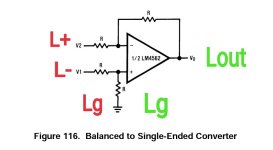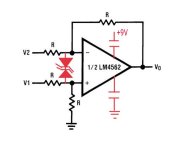I need to hook up a subwoofer to the other side of the room (maybe a 30ft run), but I don't have enough coax.
My preamp has balanced outputs so I'm thinking twisted pairs are appropriate. Does this sound like a good plan?
I'll make up an xlr to a cat6a cable. At the preamp end, L+ and L- will go on one twisted pair. R+ and R- go on another twisted pair. And Lgnd and Rgnd go to 2 other wires.
At the subwoofer end, I'll use this simple opamp balanced to single ended converter. Then left and right RCAs to the subwoofer amp, which sums the inputs.
I'm also open to using transformer for the balanced to single ended, but I have a feeling that will be expensive.

My preamp has balanced outputs so I'm thinking twisted pairs are appropriate. Does this sound like a good plan?
I'll make up an xlr to a cat6a cable. At the preamp end, L+ and L- will go on one twisted pair. R+ and R- go on another twisted pair. And Lgnd and Rgnd go to 2 other wires.
At the subwoofer end, I'll use this simple opamp balanced to single ended converter. Then left and right RCAs to the subwoofer amp, which sums the inputs.
I'm also open to using transformer for the balanced to single ended, but I have a feeling that will be expensive.

Using Ethernet cable would work but the lack of shielding would mean it would be more prone to picking up noise which the matching (ie balancing) of your resistors, in your circuit, would be important in reducing the common mode rejection.
At audio frequencies not much advantage of using cat6a over cheaper cat5.
Transformers have good common noise rejection and there is cheap options but they have their own disadvantages. So I would stick with your circuit with a few extra flourish’s such as input caps and input protection diodes.
At audio frequencies not much advantage of using cat6a over cheaper cat5.
Transformers have good common noise rejection and there is cheap options but they have their own disadvantages. So I would stick with your circuit with a few extra flourish’s such as input caps and input protection diodes.
Linn KNEKT used CAT cables for multi-room with very good performance. Think it was balanced signal with current (not voltage) for low interference/noise.
Hi, I'm using rj45 cable to transfer from DSP to amp, 4 balanced channels other side of the room. Using products like these: https://www.thomann.de/gb/the_sssnake_cat_snake_5mc.htm
https://www.thomann.de/gb/pro_snake_cat6e_cable_10m.htm
Got different length cables for different occasions, currently some random rj45 cable from local grocery store since needed longer ones after adjusting furnishing. Don't even know if it is shielded or not, works just fine.
10m is quite short run after all.
https://www.thomann.de/gb/pro_snake_cat6e_cable_10m.htm
Got different length cables for different occasions, currently some random rj45 cable from local grocery store since needed longer ones after adjusting furnishing. Don't even know if it is shielded or not, works just fine.
10m is quite short run after all.
Last edited:
The caps would be directly on the input connector to chassis ground to reject RF, perhaps 100pF to 470pF, ceramic. They prevent RF signals getting to the semiconductor devices.
Input protection diodes are between inputs and both power rails so they prevent input excursions outside the power rail voltage range whether the circuit is powered on or not. Often Schottkys are used, though in an opamp circuit you need to worry about stray capacitance - they might be better placed on the inputs to the whole circuit, not on the opamp inputs directly.
This circuit with input resistors will be fairly robust anyway due to the resistors.
Input protection diodes are between inputs and both power rails so they prevent input excursions outside the power rail voltage range whether the circuit is powered on or not. Often Schottkys are used, though in an opamp circuit you need to worry about stray capacitance - they might be better placed on the inputs to the whole circuit, not on the opamp inputs directly.
This circuit with input resistors will be fairly robust anyway due to the resistors.
Shielded Ethernet cables are readily available. Sending line level signals over CAT6 is well established. Thomann supply boxes that send four balanced pairs down a Cat6 cable:
https://www.thomann.de/gb/the_sssnake_ka_cat_splitter_adaptors.html
Cheers
Ian
https://www.thomann.de/gb/the_sssnake_ka_cat_splitter_adaptors.html
Cheers
Ian
- Home
- Source & Line
- Analog Line Level
- Using Cat6 for a long balanced audio
